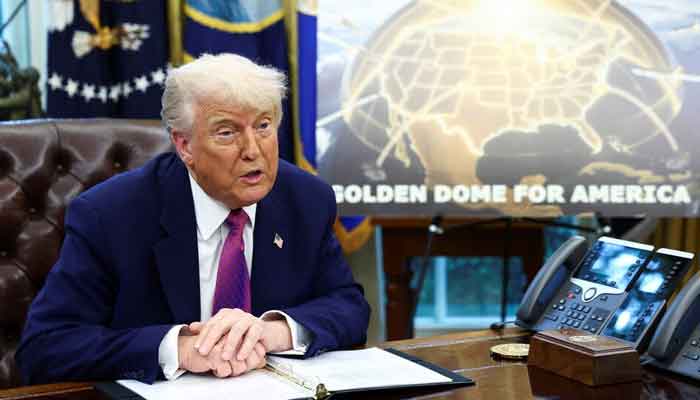US President Donald Trump has selected a design for his ‘Golden Dome’ missile defense system and named a leader for the ambitious $175 billion defense program. Here are details on Golden Dome, its conceptual origins, and its proposed functionality.
How Will It Work?
The objective of Golden Dome is to leverage a network of hundreds of satellites orbiting the globe, equipped with sophisticated sensors and interceptors, to neutralize incoming enemy missiles shortly after they launch from countries such as China, Iran, North Korea, or Russia.
“I promised the American people that I would build a cutting-edge missile defense shield to protect our homeland from the threat of foreign missile attack,” Trump stated during his announcement on Tuesday.
In April, the Pentagon solicited proposals from defense contractors on how they would design and construct a network capable of neutralizing intercontinental ballistic missiles during their “boost phase”—the slow and predictable ascent of an enemy missile through Earth’s atmosphere, immediately after lift-off. Existing defense systems typically target enemy missiles while they are traveling through space.
Once a missile is detected, Golden Dome will either shoot it down before it enters space with an interceptor or a laser, or further along its trajectory in space using an existing missile defense system that deploys land-based interceptors stationed in California and Alaska.
Beneath the space intercept layer, the system will feature an additional defensive layer based in or around the U.S. This concept was explored by the Pentagon’s Missile Defense Agency during the first Trump administration.
Is Golden Dome Similar to Israel’s Iron Dome?
“We helped Israel with theirs, and [it] was very successful, and now we have technology that’s even far advanced from that,” Trump remarked, referring to Israel’s Iron Dome missile defense system.
The short-range Iron Dome air defense system was specifically developed to intercept rockets fired by groups like Hamas in Gaza.
Developed by Israel’s Rafael Advanced Defense Systems with U.S. backing, it became operational in 2011. Each truck-towed unit fires radar-guided missiles to destroy short-range threats such as rockets, mortars, and drones in mid-air.
The system determines whether a rocket is on a trajectory to strike a populated area; if not, the rocket is disregarded and allowed to land harmlessly.
Iron Dome was initially advertised as providing city-sized coverage against rockets with ranges between 4 and 70 km (2.5 to 43 miles), although experts suggest this capability has since been expanded.
How Does It Resemble Then-President Ronald Reagan’s Star Wars Initiative?
“We will truly be completing the job that President Reagan started 40 years ago, forever ending the missile threat to the American homeland,” Trump declared on Tuesday.
The concept of attaching rocket launchers, or lasers, to satellites to shoot down enemy intercontinental ballistic missiles is not new. It was a core component of the Star Wars initiative, formally known as the Strategic Defense Initiative (SDI), conceived during Ronald Reagan’s presidency. However, it represents a monumental and costly technological leap from current capabilities.
Reagan’s SDI, announced in 1983, was presented as groundbreaking research into a national defense system that could render nuclear weapons obsolete.
The core of the SDI program was a plan to develop a space-based missile defense system capable of protecting the U.S. from a large-scale nuclear attack.
The proposal envisioned multiple layers of technology that would enable the United States to automatically identify and destroy a vast number of incoming ballistic missiles as they were launched, during their flight, and as they approached their targets.
SDI ultimately failed due to its prohibitive cost, overly ambitious technological scope, difficulty in testing, and apparent violation of an existing anti-ballistic missile treaty.
Who Will Build Golden Dome?
Trump ally Elon Musk’s rocket and satellite company, SpaceX, has emerged as a frontrunner alongside software firm Palantir and drone manufacturer Anduril to construct key components of the system.
Many of the initial systems are expected to be sourced from existing production lines. Attendees at the White House press conference with Trump mentioned L3Harris Technologies, Lockheed Martin, and RTX Corp as potential contractors for this massive project.
L3 has invested $150 million in establishing its new facility in Fort Wayne, Indiana, where it manufactures the Hypersonic and Ballistic Tracking Space Sensor Satellites. These are part of a Pentagon effort to enhance the detection and tracking of hypersonic weapons using space-based sensors and could be adapted for Golden Dome.
However, Golden Dome’s funding remains uncertain. Republican lawmakers have proposed a $25-billion initial investment for it as part of a broader $150-billion defense package. Nevertheless, this funding is tied to a contentious reconciliation bill that faces significant legislative hurdles in Congress.



